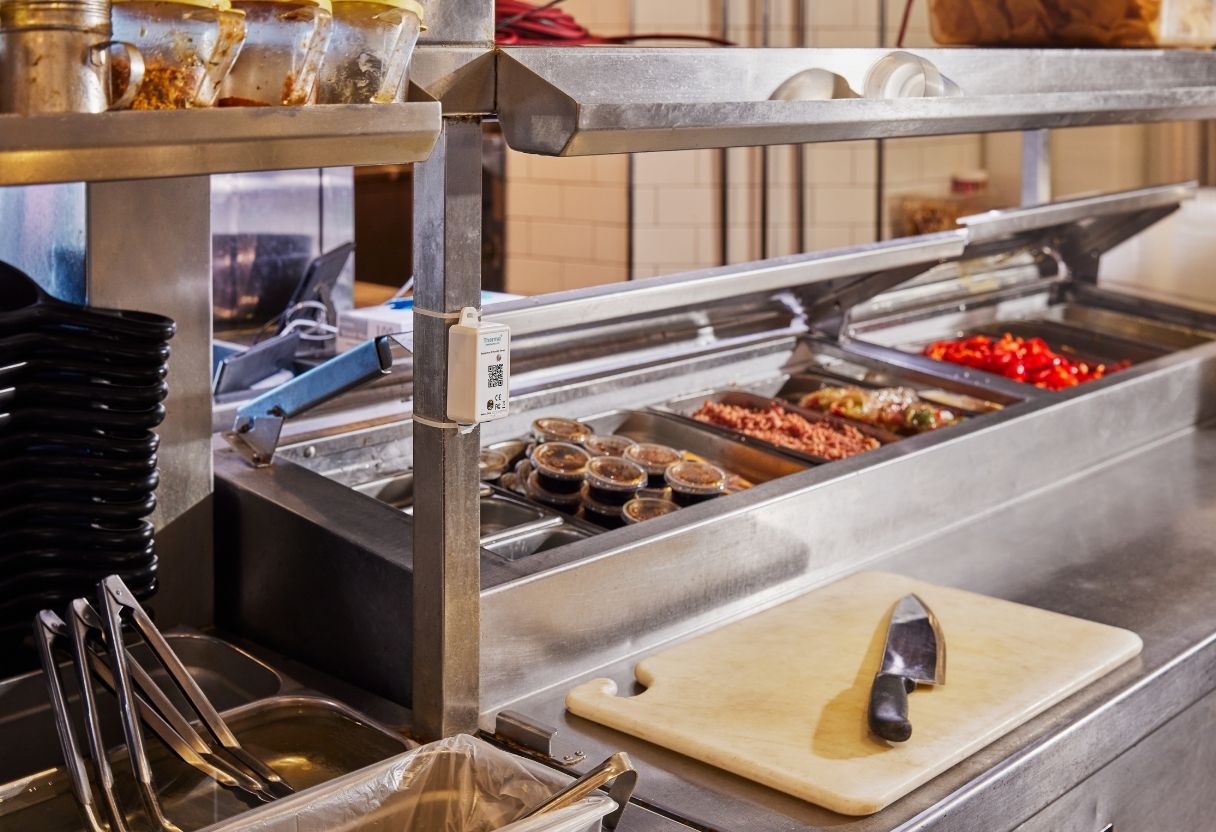Why Should You Use Temperature Probes for Monitoring Your Cold Rails?

Cold rails are commonly used in restaurants to keep prepped inventory within safe temperature zones prior to use in prepared dishes. They are found at nearly every production station within a commercial kitchen and enable textural dynamism and improve the speed of service. Ultimately, cold rails help to make meals taste fresh while cutting down on production time.
You can find cold rails on top of lowboys or other refrigeration units. Their basic design is simple: they have an open space filled with a variety of different-sized pans. Due to their placement on top of a refrigeration unit, cold air is piped in keeping prepped inventory inside the pans cool.
While cold rails are heavily relied upon in the food industry, they do have some disadvantages.
Luckily, GlacierGrid offers IoT-integrated temperature probes designed to measure the conditions within your hotel pans and inserts to prevent spoilage in some of your restaurants’ most important areas. Read to learn more.
What happens when cold rails are out of temperature?
Cold rails have long been trusted to cool prep stations efficiently during service. However, they may not be powerful enough to maintain optimal temperatures long-term. Even in an ideal setting, cold rails can only do so much to keep prepped inventory cool. One of the reasons for this is the design of the cold rails themselves. Cold rails are generally left uncovered during service.
The lack of covering allows cold air to gradually seep out and can cause gradual warming if not monitored. Even if stoves or deep fryers aren’t particularly close to cold rails, they still raise the overall ambient temperature of the kitchen. An increase in temperature may be more than a cold rail can counteract.
The most significant risk of out-of-temperature cold rails is that the inventory’s holding temp might exceed 40°F. Food stored at high temperatures for periods longer than two hours increases the risk that your inventory will spoil, and so it is required to be thrown away. This leads to higher inventory costs, wasted time, and the potential to transmit food-borne pathogens to your customers.
Unnecessary prep time
Full-service restaurants spend a significant portion of the day performing preparatory tasks such as chopping vegetables, kneading dough, or making sauces. To conduct these tasks in the most efficient manner possible, restaurants have relied on a production protocol known as “mise en place”. Mise en place is an approach that treats restaurant service like a conveyor belt. Adherents organize their tasks, create a series of steps to accomplish them and execute each step all at once.
Cooks use this method because it reduces the amount of work they have to do during service. For example, chopping garnishes, such as scallions, while cooking can prolong the time dishes take to prepare, leading to unhappy customers. Items found on cold rails usually have gone through mise en place protocols and are ready for use in dishes. If these items spoil during service, it forces cooks to prep them on the spot, increasing cooking time.
Risk of foodborne illness
Food spoilage caused by cold rail temperature spikes increases the risk of transmitting foodborne illness to your customers. Food stored at temperatures above 40°F for periods longer than two hours enters what is known as the “food safety danger zone”, and is legally mandated to be thrown away.
Bacteria is always present in food items, though proper cold storage inhibits its growth. Food storage outside of acceptable ranges encourages bacterial growth and is harmful if consumed.
The importance of temperature probes
The never-ending clash between warm and cold temperatures in the kitchen necessitates regular temperature monitoring. By regularly auditing the conditions of your prepped inventory, you can anticipate spoilage and take steps to relocate inventory before you experience the consequences.
Many restaurants require their employees to measure and record the temperatures of items stored in cold rails. Traditionally team members conduct these checks manually with thermometers and paper logs. However, this comes with its own set of problems: It’s inefficient, and it leaves room for human error.
You don’t want the employee responsible for temperature monitoring to rush through the process and miss dangerous temperature fluctuations or worse, forge the logs entirely, a practice commonly known as pencil whipping.
Even if employees do follow the proper protocols in measuring temperatures, the data may still be incorrect. Thermometers need to be calibrated by storing them in room temperature water in between uses. Storing them in warm water or leaving them dry and sitting on a surface can wildly affect their efficacy.
To combat these issues, restaurants need reliable, streamlined solutions for temperature monitoring. One solution is to implement GlacierGrid to constantly measure the conditions in your cold rail and transmit the results to the cloud. From there, you can access and monitor the data in real time from our suite of software offerings such as our mobile app or web dashboard.
A better way to measure temperature
At GlacierGrid we built our temperature monitoring and analytics platform to empower restaurant teams to react proactively, instead of reactively, to hazardous temperature excursions. Don’t wait for an emergency such as a loss event or foodborne illness to occur before considering digital temperature probes. Click below to try GlacierGrid today.







